I may have mentioned once or twice that I’m a HUGE fan of my current PC setup. Everything is setup and tuned just the way I like it. If I didn’t have other obligations, I would sit in front of my PC all day and just tinker. Everything is just so perfect!
…
… So why can’t I stop thinking about keyboards..?
I’ve been using the same keyboard for over a decade now; the razer black widow. Its a mechanical, full keyboard with mx cherry blue switches. That means its a full sized keyboard (with a numpad) and each key makes a distinct and loud “click” when it is pressed. I’ve mentioned on the podcast that I love clicky sounds, so this keyboard is a pleasure to use. But lately, I’ve just felt the desire to upgrade. Not because I NEED to, but because I WANT to. My brain is currently locked in a circular debate:
Me: But this keyboard is perfectly fine! It still works and I still like it!
Also Me: Its more than 10 years old. Have you seen some of the new features keyboards have these days?!
Me: That does look cool… but they’re so expensive for a thing I already have!
Also Me: Well, we don’t need ALL the bells and whistles… this one is quite affordable…
Me: But this keyboard is perfectly fine!
And around and around I go. Now, knowing me, I’ll let this loop run in my head for anywhere from 1 to 6 months before I finally cave and just buy the thing I want. And for no other reason than I just want the internal debate to end! So… I need a plan for when I do cave.
That means its shopping time! And boy-howdy, I wasn’t ready for the rabbit hole I fell down…
As the title says, if you are in the market for a keyboard, you are spoiled for choice. Not just make and model either; oh no. Keyboards now come in different form factors, different switches, different color-ways, different software suites, different layouts, and on and on and ON! I’m not even going to mention the massive community that buys bare electronic circuit boards and solders their own keyboards together. That at least is a step too far for me.
Having options means I need to do research, and I figured it would make for a helpful and hopefully interesting article on my little-known pseudo-blog. So, lets get started!
Form Factor
First, did you know there are different form factors of keyboard? I was vaguely aware, but I had no idea some of these existed:
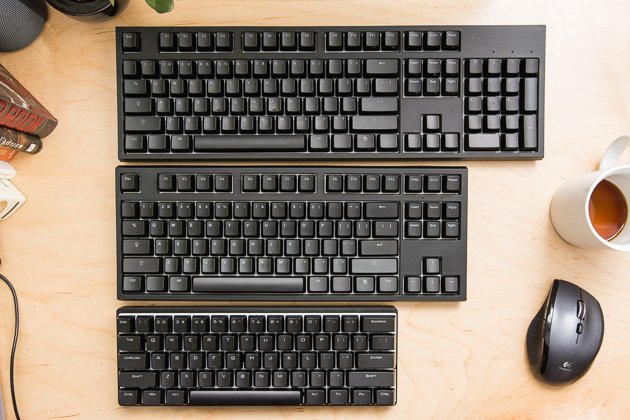
Everyone knows the full layout, and I’m sure most people know TKL from laptops. But 60%? Thats freaking tiny! And these aren’t all of the layouts, just three of the most popular! The most absurd in my mind is the 40% layout, which has a die-hard fanbase:
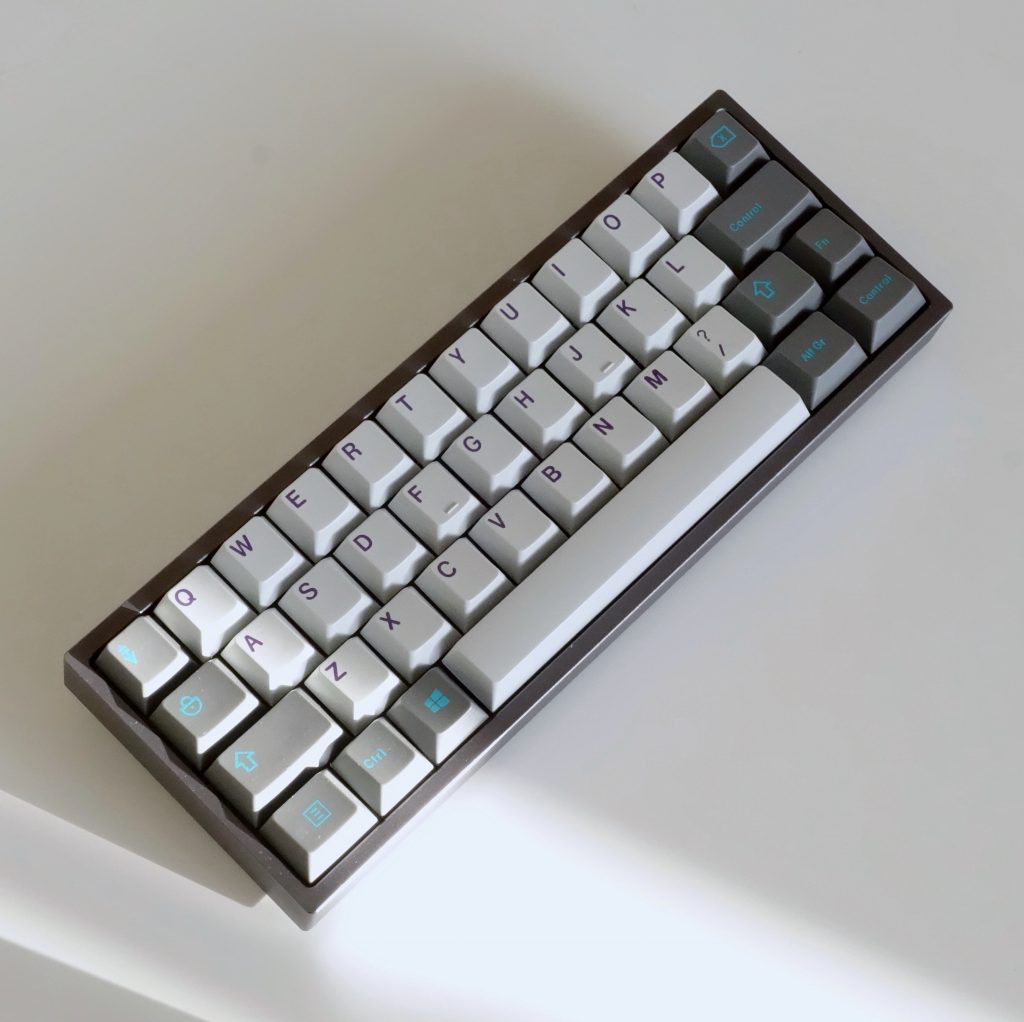
I mean… if you travelled alot and JUST did writing, but on a tablet and not a laptop, then maybe? I really don’t know what the appeal is here… thats WAY too much functionality lost for me.
Anyway, I have two considerations when looking at form factor. First, I’m accountant; I use the numpad whenever I’m working. Second, I am a big fan of keyboard shortcuts when I’m editing documents, and I use “Home” and “End” more than is probably reasonable. So, these two requirements lock me into a full sized keyboard.
Key Layout
I don’t have a ton to write about here, but there are different physical key layouts aside from the form factor that exist. The first is the simplest; ISO vs ANSI layout (or US vs European):
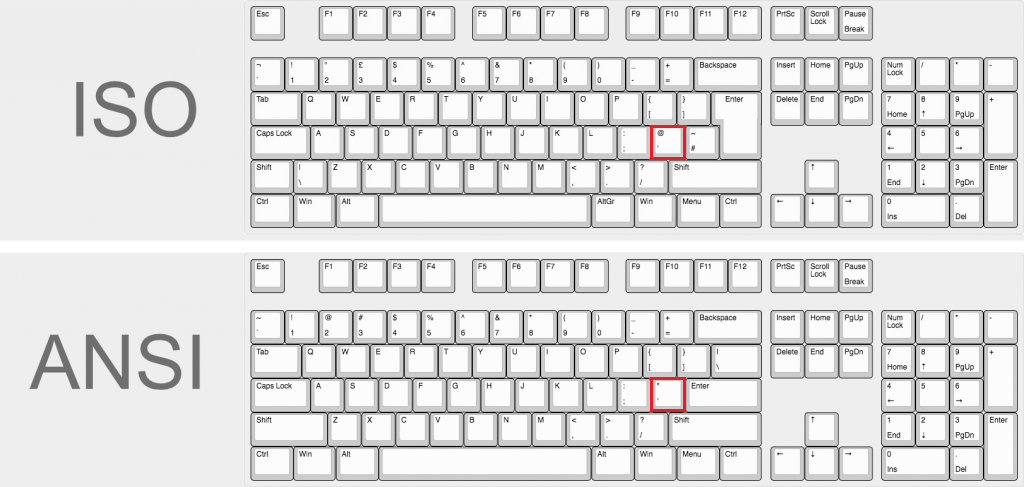
US style is the ANSI layout. No question for me here… ANSI all the way. I’ve seen and typed on ISO keyboards in the past, but that was in the before times, when the @ symbol wasn’t necessary in day-to-day life.
This next one is more obscure… ever heard of ortholinear? Well, check out this craziness:
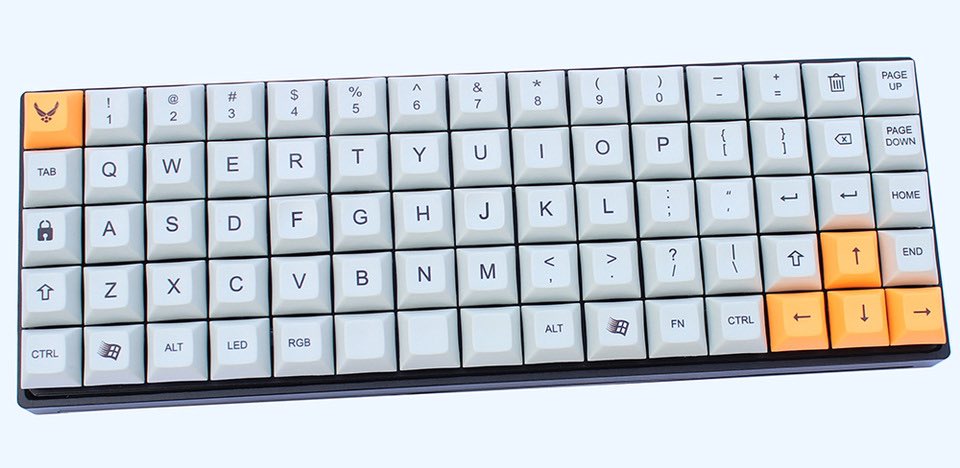
The difference here is subtle but profound. All the keys are the same size and laid out in a perfect grid. Look down at your keyboard; the keys are staggered. Its been that way since the good ol’ typewriter days, when the keys had to be physically connected to swing arms, and therefore spread out enough to allow physical connections.
Ortholinear keyboards are supposed to be faster (once you get used to them) and better for typing, since your fingers move less. But… for me… I’m not willing to learn a new layout…
Lastly, theres the layout that Ben I talked briefly about; Dvorak:
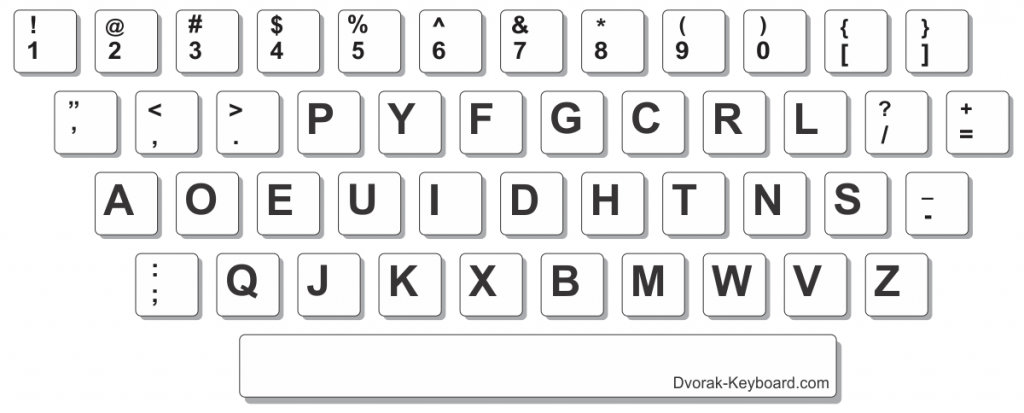
While I respect people that use this layout, I am too good at Qwerty to want to start from scratch. Sorry Dvorak, it was never meant to be…
Switches
Oh boy oh boy! I’m going to talk about different methods to complete an electrical circuit! Who else is excited?!
So, whenever you press a key on your keyboard, the physical mechanism needs to register that key press. How does it do that? Why, with switches, of course!
If you’ve never heard of keyboard switches, then you’re probably typing on a membrane keyboard. Basically, there is a flexible plastic or rubber sheet under your keys or buttons that, when pressed, make contact with a circuit underneath it:
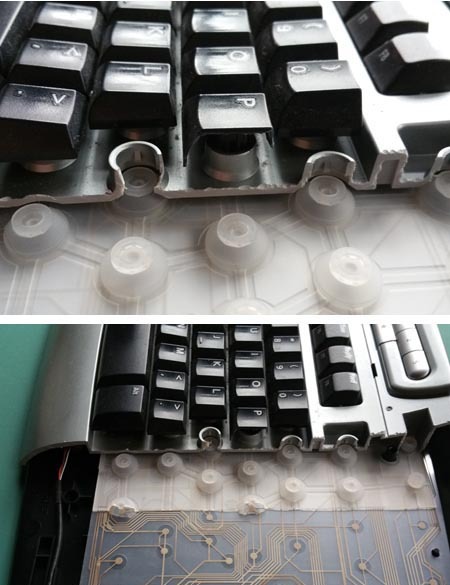
While this type of keyboard is cheap, easy to make, and is resistant to spills and dirt, its very “meh” in every other capacity. Ever since I got a mechanical keyboard, I don’t like the feeling of membrane keyboards. Ben would probably make a comparison to shoes here; if you’ve worn cheap shoes your whole life, then switch to an amazing pair of Nike Air Max 95’s, it would be tough to switch back (Nike, sponsor the podcast!)
If you’re serious about your keyboard, then mechanical is the only way to go. Mechanical switches do exactly what you think they do; they make a mechanical, metal on metal circuit connection when you press a key. The difference here is the customization. Since its a physical mechanism, clever engineers have built dozens of flavors of mechanical switch, each with its own unique characteristics!
I’m going to be very general here, because this article is already pretty boring… but if you want the full scoop, I recommend going to YouTube; I’m not the only person obsessed with keyboards and switches.
In general, there are three “families” of mechanical switches. “Clicky” switches have a tactile and audible click when they actuate. “Tactile” switches have a tactile bump without the audible click when they actuate. “Linear” switches just actuate when they actuate, and you don’t get any feedback from the key until it bottoms out.
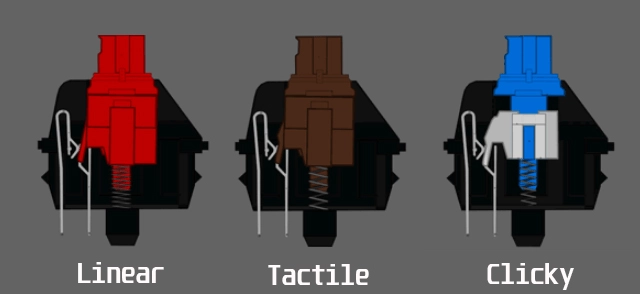
Because there are so many different types of mechanical switch, you can fine tune the perfect typing experience just for you. If you have never felt a mechanical keyboard I HIGHLY encourage you to go to a big box computer store and just mess around on their floor models. I can’t stress this enough; a good mechanical keyboard will change the way you interact with your computer.
I LOVE (all caps) clicky switches. My brain cannot get enough of the sounds they make. Every key press is like a little ASMR video just for me.
Bells and Whistles
Turns out, ten years is a long time in computer years. While my current keyboard works as intended, I had no idea how many quality of life improvements have been made to keyboards in the meantime. Here are just some of the improvements I’ve seen while shopping around:
- Wireless – You can now get wireless keyboards that work with little USB dongles or bluetooth, and most keyboards offer both and let you switch between them!
- RGB – For the uninitiated, RGB stands for Red-Green-Blue. It means that keyboards now have built in multi-color lights that can create a spectrum of colors and effects. It doesn’t change the functionality of the keyboard, but it sure is pretty!
- Floating Keys – I’m not sure if this is the correct term, but I’m going to use it here. Most mechanical keyboards I’ve seen lately have set their keys above the faceplate or body of the keyboard. This is nice because my current keyboard has keys that are below the faceplate, and they’re difficult to clean. If dirt or dust gets under my keys, its just going to live there until I tear the whole keyboard down again. Having floating keys would let me clean the keyboard in no time.
- Media Controls – Most higher end keyboards now have dedicated media controls built in. Who doesn’t listen to music while they’re on their computer? Having dedicated buttons to adjust the volume, play and pause, or skip tracks would make life just a tiny bit easier.
- USB Passthrough – I don’t use USB drives often, but when I do, its a pain to get them plugged in. An extra USB port or two on my keyboard sure would be nice.
The Winner
So, now that you have an idea of what I’m talking about, here is what I know I want:
- Full Keyboard
- Mechanical, clicky switches
- Preferably one from Razer (I have two other Razer peripherals, and the matching aesthetic is a plus, but not a requirement)
- ANSI, QWERTY layout (this one is easy since its the standard in the US)
- As many bells and whistles as I can reasonably get
I spent a good month shopping around before the algorithms caught me. I was surfing Razer’s site for the thousandth time when I saw a keyboard that checked all the boxes on sale for 25% off. I’m almost certain there was some bot on Razer’s servers watching me the way a fisherman watches a baited lure. Sure enough, I took the bait…
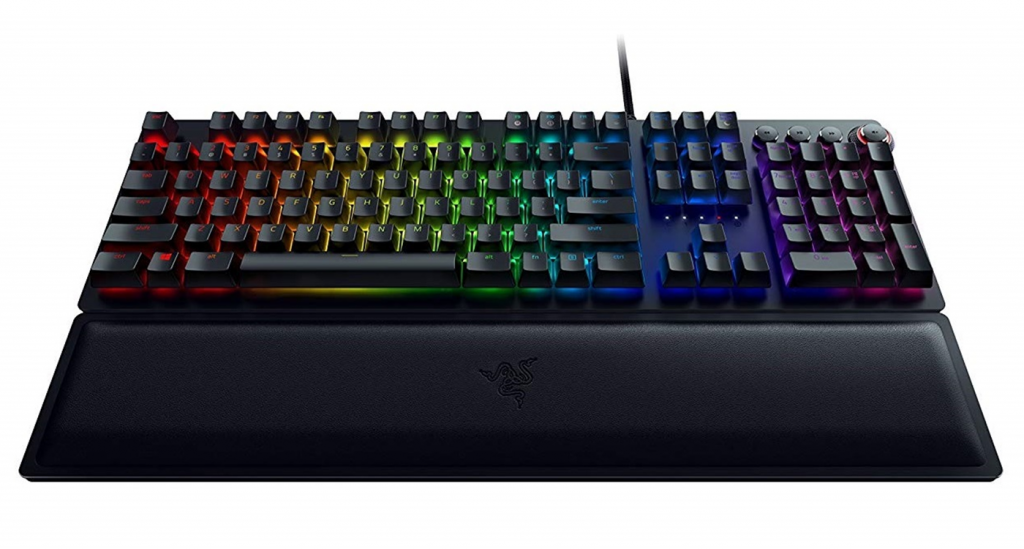
The Razer Huntsman Elite is a full sized, ANSI layout, QWERTY keyboard with RGB, Media Buttons, floating keys, and a detachable wrist rest! It has clicky optical switches, which I didn’t mention above. Basically, their clicky switches that don’t use metal on metal contact to determine if the switch was pressed; instead, when you press the key, a laser is allowed to pass through a channel under the key to a light sensitive diode (or something). In layman’s terms, this means the switches have a 25% longer useful life. And they’re still clicky!
I typed this entire article on this keyboard and let me tell you… I love it. Its slightly smaller than my previous Black Widow, which gives me more room for my mouse. The keys give me the same satisfying click when I press them, but without a tinny reverb that the Black Widow had. I didn’t even notice the reverb until I got this keyboard though, so I’m not holding that against the old girl. Lastly, since my mouse is also Razer, the RGB syncs across both of the devices to bring some symmetry to the whole desk.
As a last note, I wrote this conclusion while my lovely wife sat next me. She asked me to add her thoughts:
“Its loud as f*** and I hate it”
I can think of no better way to end this article.
This was an engaging and well written read. 👏